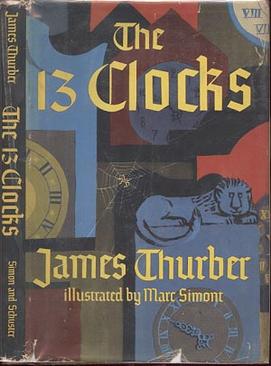The 13 Clocks facts for kids
 |
|
| Author | James Thurber |
|---|---|
| Illustrator | Marc Simont |
| Cover artist | Marc Simont |
| Country | United States |
| Language | English |
| Genre | Fantasy |
| Publisher | Simon & Schuster |
|
Publication date
|
January 1, 1950 |
| Media type | Print (hardcover) |
| Pages | 124 pp |
| ISBN | 0-671-72100-3 |
| OCLC | 25330722 |
The 13 Clocks is a magical fantasy story written by James Thurber in 1950. It tells the tale of a brave prince who must complete a very difficult challenge to rescue a beautiful princess. She is held captive by a mean duke. The story is written in a special way, almost like a poem, and uses many ideas from classic fairy tales.
James Thurber wrote this book when he was losing his eyesight. Because of this, he could not draw the pictures himself. He asked his friend Marc Simont to create the illustrations for the first edition. One of the characters, the Golux, wears a very strange hat. Thurber made Simont describe all his drawings, and he was happy when Simont could not describe the Golux's hat! Later, when the book was printed again by Puffin Books, Ronald Searle drew new pictures for it. The book has been re-released by The New York Review Children's Collection with the original drawings by Marc Simont. It also includes an introduction written by Neil Gaiman.
What is The 13 Clocks About?
The Evil Duke and His Frozen Castle
The story takes place in a very cold place called Coffin Castle. An evil ruler, the Duke, lives there with his kind and beautiful niece, Princess Saralinda. It's so cold in the castle that all the clocks have stopped at ten minutes to five. Many princes have tried to marry Saralinda. But the Duke always gives them impossible tasks to complete first.
Prince Zorn's Secret Mission
A few days before Saralinda's twenty-first birthday, a brave hero named Prince Zorn arrives. He comes from the land of Zorna. To keep his identity a secret, he pretends to be a traveling singer. He soon meets a mysterious and helpful guide known as the Golux. The Duke's guards quickly arrest Prince Zorn for singing songs that made fun of the Duke.
The Duke's Impossible Challenge
The Duke soon finds out that "Xingu" (Prince Zorn's fake name) is actually a prince. He decides to let Prince Zorn try to win Saralinda's hand. The Duke gives Zorn two very hard tasks. First, he must find a thousand jewels. He only has 99 hours to do this, which is not enough time to get jewels from his own kingdom. Second, the Duke demands that Zorn must find a way to make the thirteen frozen clocks start ticking again.
The Quest for Weeping Jewels
Prince Zorn and the Golux travel to the home of a woman named Hagga. She has a special magical power: she weeps jewels instead of tears! Hagga explains that she has cried so many jewels for others that she can no longer cry from sadness. Now, she only cries jewels when she laughs. She also warns them that these "laughter jewels" will turn back into tears after two weeks (fourteen days). Even with this warning, the Golux and Zorn get a thousand of these special, but temporary, jewels from her.
Returning to the Castle and Victory
The Prince and the Golux return to Coffin Castle with the jewels. With help from Princess Saralinda, the Golux figures out how to restart all thirteen clocks. When the Duke sees the thousand jewels and hears the clocks striking, he has to admit that he has been defeated. Prince Zorn and Princess Saralinda happily leave the castle by ship. They first travel to the kingdom of Yarrow, where Saralinda's father lives, and then continue to Prince Zorn's home in Zorna.
The Duke's Unhappy End
Two weeks later, the Duke is admiring his new jewels. Suddenly, they all turn back into tears, just as Hagga had warned! The Duke becomes very angry because he lost his chance for revenge and his treasure. As punishment for not being evil enough, a scary monster called the Todal, sent by the Devil, then kills the Duke.
The 13 Clocks on Stage and Screen
This story has been turned into different types of shows.
Television and Radio Adaptations
In 1953, the story was made into a musical for a TV show called The Motorola Television Hour. Basil Rathbone played the evil Duke. The BBC also made a radio version of the story in December 1973. Later, in 1983, a three-part TV show called Jackanory showed the story on BBC One.
Music and Opera
In 1968, a movie studio called Warner Bros. planned to make a film of The 13 Clocks. The famous Sherman Brothers wrote music for it. However, the movie was never made. You can find their music on a CD called Unsung Sherman Brothers. In 2002, a composer named Christopher Theofanidis wrote an opera based on the story.
Audiobooks
Many actors have read The 13 Clocks for audio recordings. These include Lauren Bacall, Peter Ustinov, and Edward Woodward.
See also
 In Spanish: Los 13 relojes para niños
In Spanish: Los 13 relojes para niños

